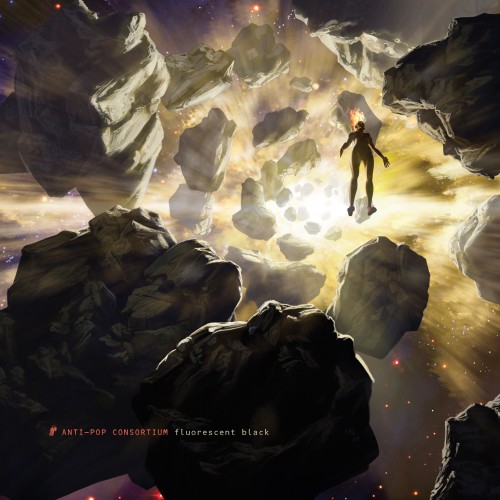
Anti-Pop Consortium
On Big Dada
BIOGRAPHY
Anti-Pop Consortium formed in 1997 when Beans, High Priest, M. Sayyid and producer Earl Blaize met at a poetry slam in New York City. The four of them put out a series of mixtapes (proper cassettes!) on their own Anti-Pop Records and called them “Consortium” volumes 1, 2 and 3. The people who were picking up the tapes began to refer to the coalition behind them as the Anti-Pop Consortium and the group as we now know it was born. The Consortium’s embl...
Anti-Pop Consortium formed in 1997 when Beans, High Priest, M. Sayyid and producer Earl Blaize met at a poetry slam in New York City. The four of them put out a series of mixtapes (proper cassettes!) on their own Anti-Pop Records and called them “Consortium” volumes 1, 2 and 3. The people who were picking up the tapes began to refer to the coalition behind them as the Anti-Pop Consortium and the group as we now know it was born.
The Consortium’s emblem – a stylised corporate stick figure with a burning head – was also already in place, created by the graphical smarts of High Priest himself. With it, the team began their assault with an infamous xerox and sticker campaign that landed Priest in jail for vandalism under Giuliani's “increased standard of living regime.” Coupled with the verbal pyrotechnics of their live show, the Consortium gained the favor of both staunch B-boy purists and experimental electronics heads. The backpackers were in awe of the group’s varied and contrasting, quickfire rhyme styles, whereas the techies loved their four man MPC jams.
Dan The Automator signed the group to be the first act on his new imprint, 75 Ark. The result was “Tragic Epilogue,” an album made up of tracks taken from the last mixtape plus some new material. It was swiftly followed by “Shopping Carts Crashing,” released on a Japanese label and exported to fans across the world. But then, in an iconic move, APC signed to UK electronic label, Warp .
The classic “Arrhythmia” followed in 2002 and took APC’s sound to a worldwide audience. To promote it they went out on Radiohead’s world tour and returned to the States to go straight out on a giant DJ Shadow tour. The album was receiving great notices and cemented their status as landmark innovators. But differences over their next creative step, plus the pressures of constant touring all took their toll. “We broke up,” Sayyid explains, “six months after that record was released.”
In 2007 the group re-formed and signed to Big Dada for the release of "Fluorescent Black." The album was once again rapturously received and the group have been touring on and off since.
Anti-Pop Consortium
On Big Dada
Albums
Singles
Latest News
BIOGRAPHY
Anti-Pop Consortium formed in 1997 when Beans, High Priest, M. Sayyid and producer Earl Blaize met at a poetry slam in New York City. The four of them put out a series of mixtapes (proper cassettes!) on their own Anti-Pop Records and called them “Consortium” volumes 1, 2 and 3. The people who were picking up the tapes began to refer to the coalition behind them as the Anti-Pop Consortium and the group as we now know it was born. The Consortium’s emblem – a stylised co...
Anti-Pop Consortium formed in 1997 when Beans, High Priest, M. Sayyid and producer Earl Blaize met at a poetry slam in New York City. The four of them put out a series of mixtapes (proper cassettes!) on their own Anti-Pop Records and called them “Consortium” volumes 1, 2 and 3. The people who were picking up the tapes began to refer to the coalition behind them as the Anti-Pop Consortium and the group as we now know it was born.
The Consortium’s emblem – a stylised corporate stick figure with a burning head – was also already in place, created by the graphical smarts of High Priest himself. With it, the team began their assault with an infamous xerox and sticker campaign that landed Priest in jail for vandalism under Giuliani's “increased standard of living regime.” Coupled with the verbal pyrotechnics of their live show, the Consortium gained the favor of both staunch B-boy purists and experimental electronics heads. The backpackers were in awe of the group’s varied and contrasting, quickfire rhyme styles, whereas the techies loved their four man MPC jams.
Dan The Automator signed the group to be the first act on his new imprint, 75 Ark. The result was “Tragic Epilogue,” an album made up of tracks taken from the last mixtape plus some new material. It was swiftly followed by “Shopping Carts Crashing,” released on a Japanese label and exported to fans across the world. But then, in an iconic move, APC signed to UK electronic label, Warp .
The classic “Arrhythmia” followed in 2002 and took APC’s sound to a worldwide audience. To promote it they went out on Radiohead’s world tour and returned to the States to go straight out on a giant DJ Shadow tour. The album was receiving great notices and cemented their status as landmark innovators. But differences over their next creative step, plus the pressures of constant touring all took their toll. “We broke up,” Sayyid explains, “six months after that record was released.”
In 2007 the group re-formed and signed to Big Dada for the release of "Fluorescent Black." The album was once again rapturously received and the group have been touring on and off since.


